In this Good Practice Note, Dr Nithya Shree traces the evolution of the Krishi Community Radio Station (KCRS) at Dharwad, and how it is impacting communities around the station. She also presents some of the challenges KCRS is facing and the lessons learnt from production and broadcasting of agricultural programmes.
CONTEXT
Community radio is a versatile and cost-effective medium that holds the potential to safeguard and advance the cultural, linguistic, and ethnic diversity of a country. Educational institutions and civil society organizations have established community radio stations (CRS) to provide programmes of immediate relevance to the community within a range of 10-15 kilometers from their location. The Krishi Community Radio Station in Dharwad is a unique initiative that was launched on 17 May 2007, from the University of Agricultural Sciences, Dharwad (UAS-D), making it the first CRS established under any of the state agricultural universities in India, and the first in Karnataka State. Since its inception, this CRS has been serving the farmers and rural communities within its broadcasting reach.
THE BEGINNING
The University of Agricultural Sciences, Dharwad, has been serving the farming and rural community in North Karnataka since its establishment in 1986. In 2006, the Government of India introduced new Community Radio Guidelines that allowed NGOs, educational institutions, and agricultural institutions to establish and operate community radio stations. Recognizing the potential of radio broadcasting to be a cost-effective means of reaching the masses, the university applied to the Ministry of Information and Broadcasting for the establishment of Krishi Community Radio Station (KCRS). With a budget of Rs. 15 lakhs, the university established KCRS which can reach 65 villages within a radius of 9-12 kilometers. On 17 May 2007, KCRS began broadcasting with the objective of providing scientific knowledge on cultivation, offering solutions to farmer’s problems, and sharing best practices and experiences of farmers.
The original staffing pattern for KCRS included nine staff positions, which were as follows:
- Programme Officer: Responsible for planning and executing day-to-day programmes;
- Two Field Facilitators: Responsible for indoor recording as well as visiting fields and recording from the community;
- One Announcer (also known as ‘Radio Jockey’): Responsible for on-air announcements;
- One Editor: Responsible for editing programmes and preparing the daily playlist, having computer skills;
- Two Technicians: Responsible for equipment maintenance;
- Two Transmission Assistants: Responsible for starting, ending, and running programmes.
However, due to a shortage of funds during the COVID-19 pandemic, the total staff was reduced to six. So, the Field Facilitators also perform the duties of the Announcer now, while the Transmission Assistants use their experience to also perform the work of the Technicians.
Additionally, a few community members have been identified to coordinate programmes, and they are not paid salaries but receive an honorarium whenever involved in a programme.
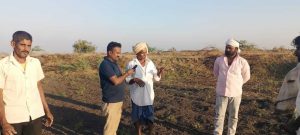 Recording experiences of a farmer in the field
Recording experiences of a farmer in the field
PROGRAMME PLANNING AND CONTENT DEVELOPMENT
Programme planning is primarily done by the programme officer in consultation with the field facilitators and scientists at the university. An Advisory Committee was formed with the Vice Chancellor of the University as the Chairman, along with the Director of Research, Director of Extension, Deans of Agriculture, Community Science, and Forestry, Associate Director of Extension, Associate Director of Research, Head of Krishi Vigyan Kendra, Director of All India Radio Dharwad, and heads of line departments such as agriculture, horticulture, fisheries, animal husbandry, forestry, women and child welfare, marketing, health, and social welfare as members. This committee meets once every six months and approves the list of programmes to be aired by the station.
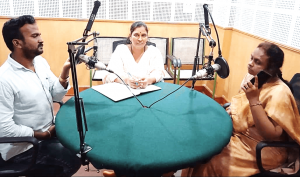 Programme Officer and staff recording a phone-in programme
Programme Officer and staff recording a phone-in programme
A minute-to-minute programme outline for broadcasting under different types of programmes is chalked out every week and the programme officer plan what should be covered under each one in consultation with field facilitators. Based on the season and needs of the farmers scientists working at the university, together with the Indian Council of Agricultural Research (ICAR) stations in the region, Krishi Vigyana Kendra, and State Department of Agriculture and other line departments serve as resource persons and prepare the programmes.
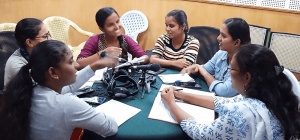 Students involved in planning and recording of the programme
Students involved in planning and recording of the programme
With respect to agriculture, the main focus is on the crops grown in the coverage area. The programmes are broadcast every day from 6 AM to 9 AM and 6 PM to 9 PM. The programme broadcasted in the morning is repeated in the evening. These hours were selected for broadcasting as farmers are generally free during this time.
Every day approximately 25 to 28 programmes are aired. The topic of broadcast under each programme will be decided by the programme officer in consultation with field facilitators 15 days in advance, and the work will be assigned to field facilitators. Regular agriculture programmes broadcasted include:
- Weather report & forecast;
- Scientist interviews dealing with agriculture;
- Krishi Salhe – Agriculture Advisory;
- Krishi Nudimuttu – Agriculture-related sayings and maxims;
- Krishi Chintana – Farmer-to-farmer agriculture programme;
- Raithagithe – Farmer songs; and
- Farmers’ interviews.
Apart from the regular programmes, each day has a special programme, namely:
- Krishi Patha (Hort) – Lessons on horticulture;
- Siridhanya Programme – Programme on millets;
- Gram Darshna – Rural development programme;
- Pashupalana Mahiti – Animal husbandry-related programme;
- Sawyawa Siddanna – Programme related to organic farming and others. These are aired once a week on a specific day.
The best programmes of the week are picked up and the playlist is prepared for Sunday by the programme officer. A sample programme schedule of a day is given in Box 1.
Box 1: Programme schedule for a day
|
USER INVOLVEMENT AND FEEDBACK
In villages, community members and field facilitators have been working together to form listener groups based on people’s interests. Women’s groups were formed with the assistance of Self-Help Group members. In 2012, the university distributed 500 radio sets to these groups in order to motivate the listeners. However, listeners have now downloaded the mobile app instead. Important programmes are communicated to these groups via WhatsApp, and listener groups are formed based on the crops they grow. Feedback from listeners is collected through these groups, and the mobile app also has a provision for providing feedback. Experiences from three of the most successful KCRS programmes is provided in Box 2.
|
Box 2. Successfully broadcasted KCRS programmes ‘Varada Bassanna’ is another programme related to animal husbandry and veterinary practices. The veterinary doctors at the university develop and present information in colloquial language and style, creating characters, and having conversations and discussions. The programme is aired for 15 minutes in the morning and repeated in the evening from Monday to Saturday. It is very popular among listeners, and almost sixty percent of dairy farmers in the coverage area listen to it. It has won accolades as the best skilling story in the community from the Commonwealth Educational Media Centre for Asia (CEMCA) and the national Skill Development Corporation. ‘Planet Earth’, a Department of Science and Technology-sponsored project, produced and broadcasted a series of programmes about climate change and its impact on crops, pollution, environmental problems, and climate-related uncertainties. It also had discussions on humans and animals, quality of soil ecosystem, protection of natural resources, as well as environmental and health programmes for women. This programme was broadcast for one year, with 20-minute episodes in the morning and evening on all days of the week. The programme officer selected topics in consultation with experts in a particular field, and the topics were allotted to the scientists available in the university as well as other resource persons. The women’s programme showed significant knowledge improvement among women listeners on various topics broadcasted under this programme (Gouri Yellavattimath et al. 2014). |
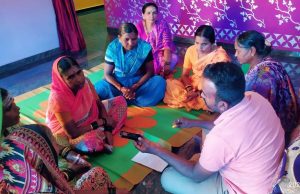 Recording the working of Women Self-Help Groups in a village
Recording the working of Women Self-Help Groups in a village
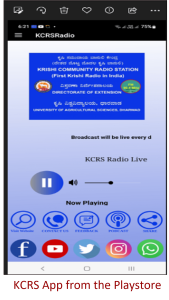 INFRASTRUCTURE
INFRASTRUCTURE
The Krishi Community Radio Station has a sound-proof recording studio with acoustics, partitions, and suitable seating arrangements for recording, as well as microphones and headphones. There is also an editing room with two input/output mixers and three desktop computers. In addition, a 50W FM transmitter and broadcast antenna have been installed. In 2022, a Digital Audio Broadcast processor and application software were added to enable internet radio, podcasting, and mobile app streaming. The mobile app, called KCRS Radio, was launched in 2022, and has helped increase the radio’s reach.
CAPACITY DEVELOPMENT OF KCRS STAFF
The staff of KCRS are sent for training and workshops conducted at the state and national levels by various community radio stations across the country, as well as by the Community Radio Association of India (https://craindia.in/), whenever such opportunities arise. The selected community members are given training once or twice a year, and need-based training is provided according to the planned programmes.
SUSTAINABILITY OF KCRS
Community radio stations are non-profit organizations that are not funded by the government, as All India Radio is. The KCRS is supported by university development grants. Previously, the government used to give advertisements on various development programmes and paid for them, but this has been stopped at present. The Community Radio Association of India is requesting the government to reintroduce this practice, which is important for the sustainability of community radios. Since their reach is limited, many organizations do not give advertisements. However, as KCRS is a part of the UAS-D, the university is taking care of its expenses, so it does not have too many financial constraints.
KCRS has completed projects that were sanctioned by the Department of Science and Technology (DST), New Delhi, from 2008-2009 and 2010-2011. The project sanctioned in the year 2008-2009 was ‘Science for Women: Nutrition and Health’. Under this, various programmes were put out for one year with two programmes per week of half an hour duration. The programmes were planned and recorded using the funds provided by DST. The project sanctioned during 2010-2011 was titled ‘Planet Earth’. In this the programmes planned were on creating awareness about environment as well as the role of women and children in protecting the environment. In the year 2013-14, NABARD sanctioned a project for the radio station titled ‘Farmer’s Voice’. This programme was created to involve farmers so that they could share their experiences and problems in agriculture and allied fields.
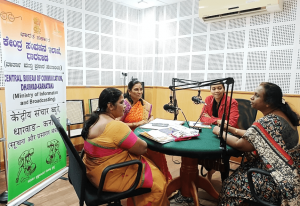 Central Bureau of Communication, Dharwad, collaborating with Community Radio for creating awareness on government development programmes
Central Bureau of Communication, Dharwad, collaborating with Community Radio for creating awareness on government development programmes
In the year 2014-15, Aids Promotion Society, Bengaluru, sponsored, created and broadcast a series of ten programmes on creating awareness about AIDS/HIV. The District Health Centre sponsors health programmes based on need. In 2020, Seeking Modern Application for Real Transformation (SMART), an NGO in New Delhi under the United Nations International Children’s Emergency Fund (UNICEF) sponsored programmes on COVID-19.
LESSONS LEARNT
- Involving the community to the maximum extent in the programmes helps to achieve maximum outreach of the programmes.
- Planning the extension activities of universities through the community radio station creates awareness among the listeners about the extension activities on and off the campus.
- Self-help groups should be involved in programme production and using ICT applications such as WhatsApp, messages, voice messages, video messages help women to engage in the programme.
- Importance should be given to local culture, traditions, and dialects so as to increase the effectiveness of the programme.
- Regular follow-up and evaluation by the university can improve the quality of the programmes and aid in its sustenance.
CONCLUSION
The Krishi Community Radio Station in Dharwad is a remarkable example of the potential of community radio in promoting agriculture and rural development. KCRS has been successful in achieving its objectives by providing scientific knowledge on cultivation, offering solutions to farmers’ problems, and sharing best practices and experiences of farmers. KCRS has also been able to adapt to changing technologies, adding a Digital Audio Broadcast processor and application software for internet radio, podcasting, and mobile app streaming.
Despite facing financial challenges during the COVID-19 pandemic, KCRS has continued to serve its community with a reduced but dedicated staff. Its programme planning is carefully structured with input from a varied advisory committee, ensuring that it provides the most relevant content to its audience. Overall, KCRS serves as a model for community radio stations that aim to promote and preserve the cultural, linguistic, and ethnic diversity of a country while serving the farming communities with need-based agriculture and allied sector information.
REFERENCE
Yelvattimath Gouri, Nithya Shree DA and Devendreppa S. 2014. Knowledge gain of the rural women through environment and health programmes. Karnataka Journal of Agricultural Science, 27(1):67-70.
 Dr Nithya Shree DA, Professor (Agricultural Extension), Dept. of Extension and Communication Management, College of Community Science, University of Agricultural Sciences, Dharwad.
Dr Nithya Shree DA, Professor (Agricultural Extension), Dept. of Extension and Communication Management, College of Community Science, University of Agricultural Sciences, Dharwad.

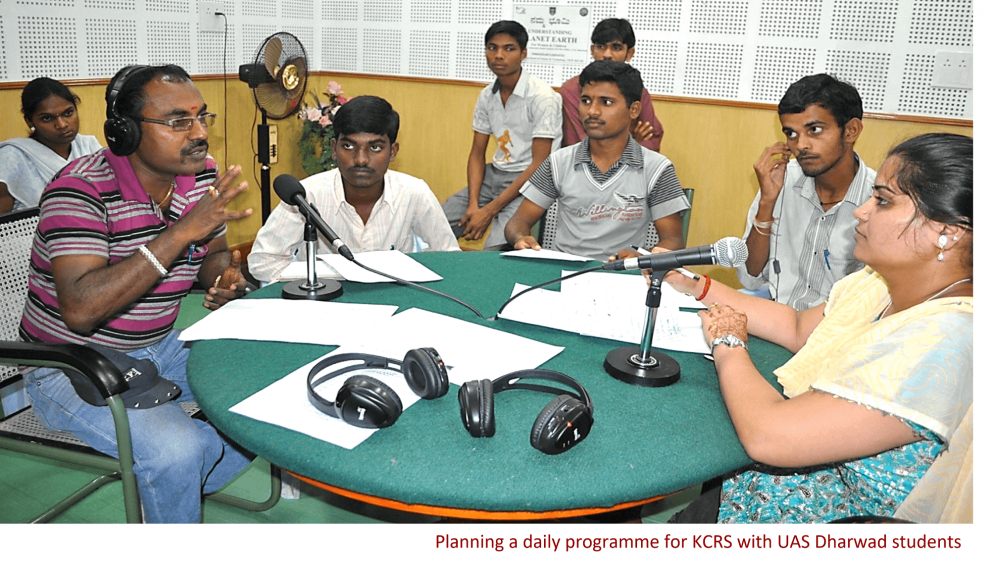

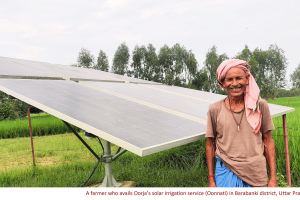
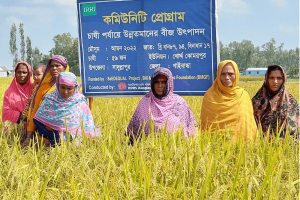
“The evolution of KCRS offers good lessons as an effective extension medium to integrate different partners and participants. Programs are well planned to cover Agricultural and veterinary advisories and success stories. CRS are excellent platforms for converting learnings and feedback for looping back to research and extension initiatives. Scientists interactions with farmers can offer direct feedback and responses. Will be interesting to know how KCRS is supporting, complementing and partnering with other media and extension agencies for increased efficiency of technology dissemination. Also any empirical studies on the media interventions statusco and the impact of KCRS will be interesting. Thank you team KCRS and AESA for the Good Practice”??